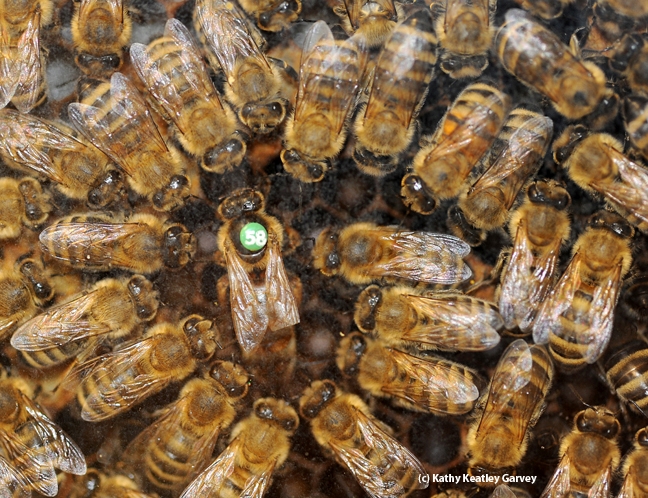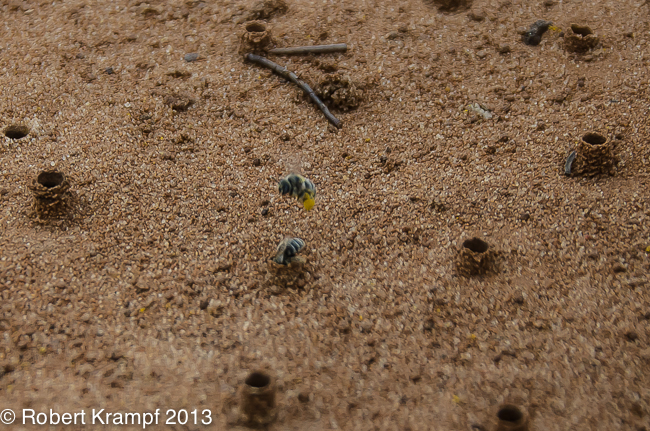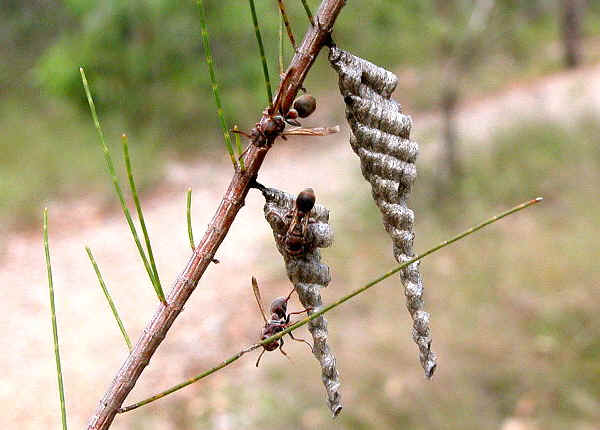What were the mechanisms that
drove solitary hymenoptera into taking that first step into social societies
and drove further advances into Eusociality? The main mechanisms that have been
hypothesised are Kin Selection and Parental Manipulation (Brian, 1983; Gauld
& Bolton, 1988). This blog entry will focus on the first mechanism - Kin Selection.
Kin selection relies heavily on genetic
asymmetry in haplo-diploid systems – genetic asymmetry means a female has three
quarters of her genes in common with her sister but only half in common with
her mother and one quarter in common with her brothers (Brian, 1983). A female
that assists in the rearing of her sisters will be genetically better off than
having her own offspring which would only have half their genes in common (Brian,
1983). This is known as inclusive fitness and is stronger than direct fitness
in haplo-diploid animals (Brian, 1983).
 |
Oecophylla
smaragdina (green weaver ants) adults caring for young in brood nest. Cairns, Queensland, Australia. Image courtesy of Alex Wild.
|
Genetic fitness may also explain
why most social hymenoptera produce very few males in comparison with females –
males are much larger than workers and require more energy from the colony to
produce but they provide very little and are essentially just breeding stock
(Brian, 1983). Females however provide protection, brood care and food
provisions making them a much wiser investment for the colony as a whole (Brian,
1983).
 |
| Apis mellifera (European honey bee) queen being tended to by her colony. Photo courtesy of Kathy Keatley Garvey. |
Kin Selection alone cannot
entirely answer the question of why socialism developed (Gauld & Bolton,
1988). If kin selection alone was the
driving mechanism then why don't other insects with haplo-diploid sex determination
that display groups of adults and juveniles have more complex social structures
like that of the Hymenoptera? The only insect species outside hymenoptera that
are eusocial are Termites that are in the Blattodea
order containing Cockroaches (Gauld & Bolton). Perhaps the answer is in the
combination of both kin selection and parental manipulation.
In the next blog entry
I will discuss Parental Manipulation as a driver behind eusocialism in the hymenoptera and reproductive altruism. Here is a video that goes into more details about haplodiploidy in social insects.
References:
Gauld, I & Bolton, B 1988, The
hymenoptera, Oxford University Press, Oxford.
Brian, MV 1983, Social Insects: ecology and behavioural
biology, Chapman and Hall, London.
Image 1, Oecophylla
smaragdina: Alex Wild: The diversity of insects, viewed 29 March 2015, <http://www.alexanderwild.com/Ants/Taxonomic-List-of-Ant-Genera/Oecophylla/i-kxngrZp/2/XL/smaragdina32-XL.jpg
>
Image 2, Apis mellifera:
Bug Squad: happenings in the insect world, viewed 29 March 2015, <http://ucanr.edu/blogs/bugsquad//blogfiles/14212_original.jpg>
Video:
‘Haplodyploidy in honeybees’, youtube, viewed 29 March 2015, <https://www.youtube.com/watch?v=pkzTHwWwhQk>




